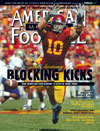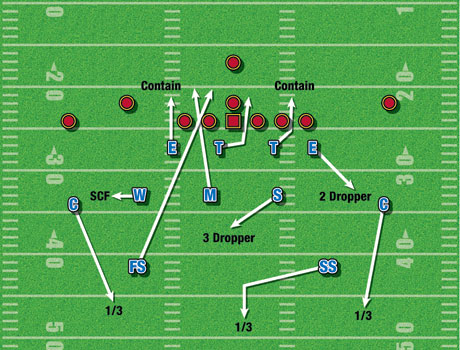AMERICAN FOOTBALL MONTHLY THE #1 RESOURCE FOR FOOTBALL COACHES
Article CategoriesAFM Magazine
|
Simplifying the Zone Blitzby: Jeff CoppSafeties Coach, Utah State University © More from this issue Today I am going to talk about our zone blitz package and some of the things that we do to simplify it for our kids. Over the last three seasons we have shifted our mentality from being a man blitz team to a zone blitz team. Our philosophy in doing this is to put as much pressure on the opposing quarterback as possible while at the same time putting our players in as safe of a situation as we can in the secondary. As with most blitz packages we try and have the ability to overload the offense’s protection from the strong side, weak side and up the middle. And we can do that and change very little in the secondary. Most of the zone blitzes that we employ are three deep, three under type blitzes. This gives you the ability to send five rushers and overload one side of the protection. Our base zone blitz is a field-oriented blitz where we send the free safety and mike LB (See Diagram 1). The most important portion of the coverage concept is the underneath defenders understanding the two dropper, three dropper and Seam-Curl-Flat drops. Once your team understands these three drops you can expand the package infinitely.
Terms and Explanation: Field End – Contains rush to the field. He gets width and puts an edge rush on the defense. Field Tackle – Long slant. As the tackle slants, his eyes transition to the center. If the center steps at him, he crosses his face; if the center steps away, he closes the A Gap. Boundary Tackle – Contains rush. Boundary tackle will slant through the B gap and put an edge on the defense. He must get vertical and close the C gap through the B Gap. Boundary End – Two Dropper. He will relate in underneath coverage on who is the #2 receiver or who becomes #2. (The TE in this Diagram). Will LB – Seam-Curl-Flat dropper. He relates to the #2 receiver on the field and eliminates the seam route first, then expands to the Curl, then the flat. Mike LB – B gap blitzer. Sam LB – Three Dropper. He relates and then drops off of the #3 receiver in the formation. (The Tailback in this diagram). Field Corner – Outside 1/3. Must see both vertical threats in his third. Boundary Corner – Outside 1/3. Must see both vertical threats in his third. Free Safety – Follows Blitzer. Safety will follow Mike on the blitz and read the guard. If the guard blocks out, he becomes the A gap player. If the guard blocks down, he becomes the C gap defender. If the guard pulls, he works over the top to the direction of the pull and fits inside the guard. Strong Safety – Middle 1/3. Must see both inside vertical threats. Once you establish the responsibilities of the underneath defenders, you may now send different combinations of blitzes and exchange the drop angles of the underneath defenders. For example, an inside blitz that we use quite often (See Diagram 2) changes who the blitzers are, the blitz angle, and the angle of the droppers. But this has done very little to the thought process of our defenders. All we have done is exchange the Sam linebacker and free safeties’ responsibilities and we now have a completely different look for the offense to block and the QB to read.
As we develop the blitzes that we are going to use during a specific game week, we first look at what pressures will give the offense trouble and what they have had problems blocking in the past. We then design the coverage components based on the defenders that we have left. Again, the key to being an effective zone blitz team is the underneath defenders understanding who they relate to and exchanging them off if receivers exchange quickly at the line of scrimmage. I hope this article has given you some ideas on how to pressure the opposing team in both the run and the pass game. As with anything you do in defensive football the most important thing is for your player to have the ability to play fast and not be slowed down by thinking. WHAT IF? Q1. What if you’re faced with a shotgun offense and a trips formation? Would you still potentially run the zone blitz? This is a three-part question. First, yes we still like zone blitzing shotgun offenses because it can define running lanes for our kids and it also forces the offense to execute the option reads with different edge looks. Second, 3x1 formations do not affect our zone blitzes. The only thing that changes is that our underneath defenders must locate where their #2 and #3 receivers are that they are relating to. Finally, a shotgun formation makes the read option a concern. We handle this by making the edge rusher an automatic QB player. Any inside blitzer is responsible for the dive portion of the option. The #2 droppers and the middle 1/3 safety are then responsible for the pitch back if there is one. Q2. What if the offense has a two-back set? Does that change the responsibilities of your defense for the zone blitz? Two-back offenses do not change the responsibilities of the anybody in our zone blitz package; it just changes the angles of the droppers. Our general rule is that if you are an underneath defender and the receiver you are relating to is in the back field, you move on to your zone drop. For example, if you are the Seam-Curl-Flat player to the field and your #2 is in the backfield he is no longer a Seam threat to you. Threfore, you can move on to your Curl-Flat portion of your drop. Q3. What if the offense comes out in a two tight end set? What adjustments, if any, are made for an effective zone blitz? Two tight end sets are similar to two-back sets in that the positon of the WRs that the underneath defenders are relating to can vary. The defenders must understand who they are relating to and if that player is a vertical threat. Just like in two-back set, if the receiver you are relating to eliminates himself as a vertical threat you can move on to the next portion of your zone drop. |
|
| HOME |
MAGAZINE |
SUBSCRIBE | ONLINE COLUMNISTS | COACHING VIDEOS |
Copyright 2024, AmericanFootballMonthly.com
All Rights Reserved






